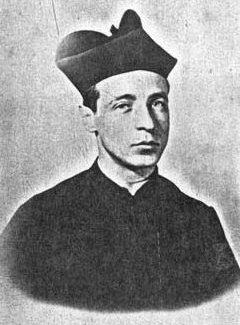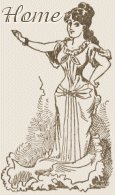|
After his death most of his work was destroyed. However, a collection of glass negatives was later found concealed in a sofa. These were photographs of prostitutes who worked in the legalised brothels of Storyville around 1912. Some were nude, some dressed respectably, others posed as if acting a mysterious narrative. In 1971 a selection of the photographs were published in a book entitled Storyville Portraits. They had been made into distinctive prints by Lee Friedlander, using the whole of the negatives.
These photographs were immediately acclaimed for their unique poignancy and beauty.
Many of the negatives were badly damaged, in part deliberately. This encouraged speculation about the reasons why they had been taken and later violated. Many of the faces had been scraped out; whether this was done by E. J. Bellocq himself, his Jesuit priest brother who inherited them after E. J.'s death, or someone else is unknown. In a few photos the women wore masks on the original photos. The influence of Bellocq's violated negatives and violated bodies can also be seen in the work of the photographer Joel Peter Witkin. Some prints made by Bellocq himself have since surfaced. These are far more conventional than the full negative prints made by Friedlander. It is likely that the faces were scraped out for the same reason that masks were used - to protect the identities of the women. In this respect Bellocq's images are one of the few visual records to remain. They confront us with an element of Storyville's past that others have tried to conceal: the prostitutes themselves. The youthful exuberance and confidence of the sitters conveys a sense of ease both with their profession and their bodies being seen as objects of desire. The way the negatives themselves came into the public domain also has a complex and convoluted history. Eighty-nine glass plate negatives were allegedly found in Bellocq's desk drawer after his death. The art dealer Larry Borenstein, along with the aforementioned Al Rose, bought the contents of Bellocq's studio. In 1966 the photographer Lee Friedlander purchased the glass plate negatives from Borenstein. However between Bellocq's death in 1949 and the time Friedlander bought them in 1966, a series of unstamped prints were made, it is thought, by the photographer Dan Leyrer and by Al Rose. A selection of some thirty five of these recently discovered earlier prints, which have only been shown once before in New York, are included in this exhibition. As unstamped images it is hard to be sure of their origins, however what is certain is that they offer us an opportunity to view many hitherto unseen images, and versions of these prints which pre-date the Friedlander works by a decade. What is startling, and at times disturbing, is the way some of the glass plate negatives have been defaced. It is easy to see the general wear and tear on the surface of the glass plate negatives, with chemicals flaking off the surface; however several of the women's faces have been dramatically scratched out. In some of the works the women themselves have concealed their identity by wearing face masks. However the intentional vandalism is more difficult to explain. It was possibly done by Bellocq himself, in order to protect the anonymity of the sitters, possibly by his Jesuit Priest brother, without Bellocq's knowledge.  This erasure mirrors Al Rose's account of the way Storyville's history had been tampered with in the public library. It also in a sense makes the images more salacious and pornographic - women whose naked bodies can be viewed but whose faces cannot.
This erasure mirrors Al Rose's account of the way Storyville's history had been tampered with in the public library. It also in a sense makes the images more salacious and pornographic - women whose naked bodies can be viewed but whose faces cannot.
Full of life and zest, the women pose in an uninhibited way before the camera. Some lie in their undergarments, others are nude, some are dressed up. We see them in their homes or work places comfortable before the camera's gaze. In the early 1900s, Ernest J. Bellocq carried his 8 x 10-inch view camera across Basin Street to photograph the women of New Orleans' notorious district of legalized prostitution, Storyville. His private photographic project remained unknown until after his death, but eventually found its way to international acclaim. Yet virtually no prostitute portraits printed by Bellocq himself have surfaced. He kept his Storyville project secret from everyone except a few of his closest friends, and it remained secret until his glass negative plates were discovered languishing in a junk shop years after his death. These older prints were made before many of the negatives sustained water damage during Hurricane Betsy, and many of the images have never been exhibited. Along with its intrinsic artistic import, the discovery of this cachet of early Bellocq prints has spurred new research on Bellocq that sheds some doubt on our current notions about him. In the dearth of information after Bellocq's Death, many almost mythic descriptions of him surfaced out of the alluvial New Orleans soil. Reports of Bellocq described him as insane, hunchbacked, grotesque, dwarfish, or hydrocephalic, leaving the world with not much choice but to consider him a virtual New Orleanian counterpart to Toulouse Lautrec. Legend also held that Bellocq's brother a Jesuit priest, was responsible for violently scratching many of the women's faces from the emulsion. Yet new research sheds some doubt on all of these ideas. Leo is Ernest's sole heir, and the negatives end up, at some point, in Sal Ruiz's antique shop. Larry Borenstein has them stashed in the deteriorated bathroom in the old slave quarters behind Preservation Hall, which was photographer Pops Whitesell's studio at one time. Apparently the roof leaks back there, too, because some of the plates get water-damaged in Hurricane Betsy. But somewhere along the line, an unknown hand had also scratched many of the women's faces from the fragile emulsion. Everyone who gave it a thought assumed that Leo had vandalized the plates as soon as he acquired them in order to protect the identities of the women, many of whom went directly to the society page after Storyville closed. But, in many cases, Bellocq photographed the same woman twice, and while one negative sustains damage, the other remains untouched, thus her identity still remains obvious. In all likelihood, Leo, being Ernest's sole heir, also had complete control of his life's work directly after his death. If protecting identities was his motive, why would Leo have randomly scratched out a face, here and there, instead of taking a hammer to the whole collection? Leo was active in the Sodality of the Immaculate Conception, a moralist organization, back when he was in school. But that was in the 1880s, and, again, a fire-breathing moralist would have destroyed the negatives rather than selectively scratching the faces. Recently, Lee Friedlander has re-examined the plates and tried to duplicate the scratching with a sample area, but the emulsion flaked off instead of scratching. The emulsion around the original defacement in some areas is folded over gently, and could only have done so when wet. Therefore, E.J. Bellocq probably defaced the negatives shortly after he developed them in the early 1900s. In one photograph, however, a woman wears a carnival mask that has been incongruously positioned to hide her eyes, possibly echoing some ambivalence that made Bellocq scratch the faces from so many of the negatives. Yet the approach to the women's faces is not the only curious aspect of Bellocq's Storyville work. In one pair of photographs, a woman stands clothed in the first image in front of heavy wooden doors, but in the second image, she is nude, her face has been scratched from the negative, and a heavy couch has been pushed in front of the door. A locket, another repeating motif in Bellocq's Storyville work, also becomes visible in the second image. One of Bellocq's defaced nudes is actually shown examining her locket. But the pair of images mentioned above is not the only example of couches in front of doors in Bellocq's Storyville nudes. One such image shows clearly that there is already a lock on the door, and a cord from an electric light has further been wrapped around the lock in what looks like a final obsessive attempt at privacy. Why would Bellocq feel the need to use a couch, a lock, and a wire to keep the door shut in an expensive brothel? Rugs used as hasty partial backdrops and, in one case, sawhorses also suggest that Bellocq may have intended to drop the backgrounds from his images, vignette, or otherwise alter the images to imitate the saccharine romantic photographs and paintings he hung on his walls. In fact, one of Bellocq's portraits is clearly shown vignetted and framed in one of the two studies of his desk. |

Tripod